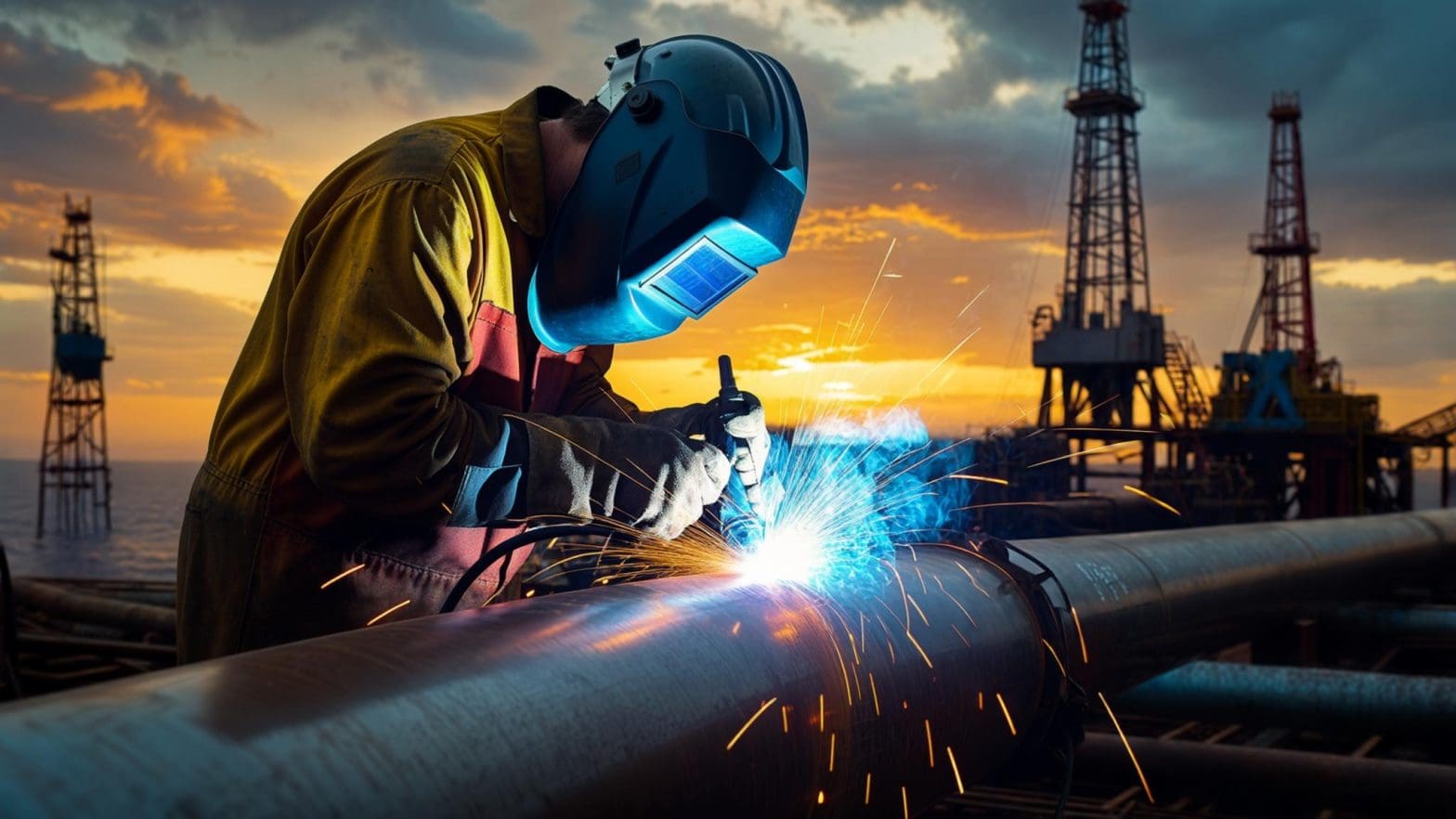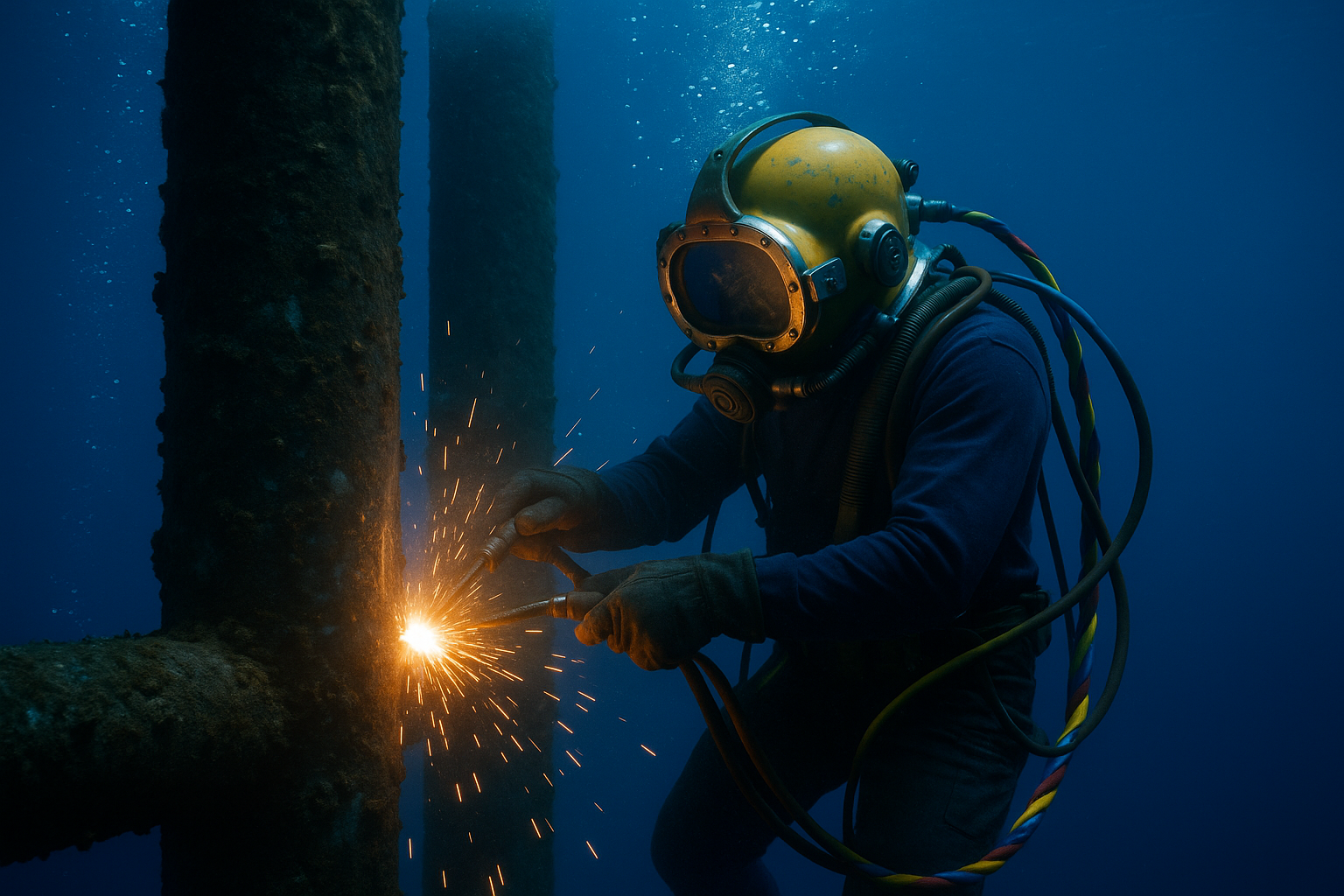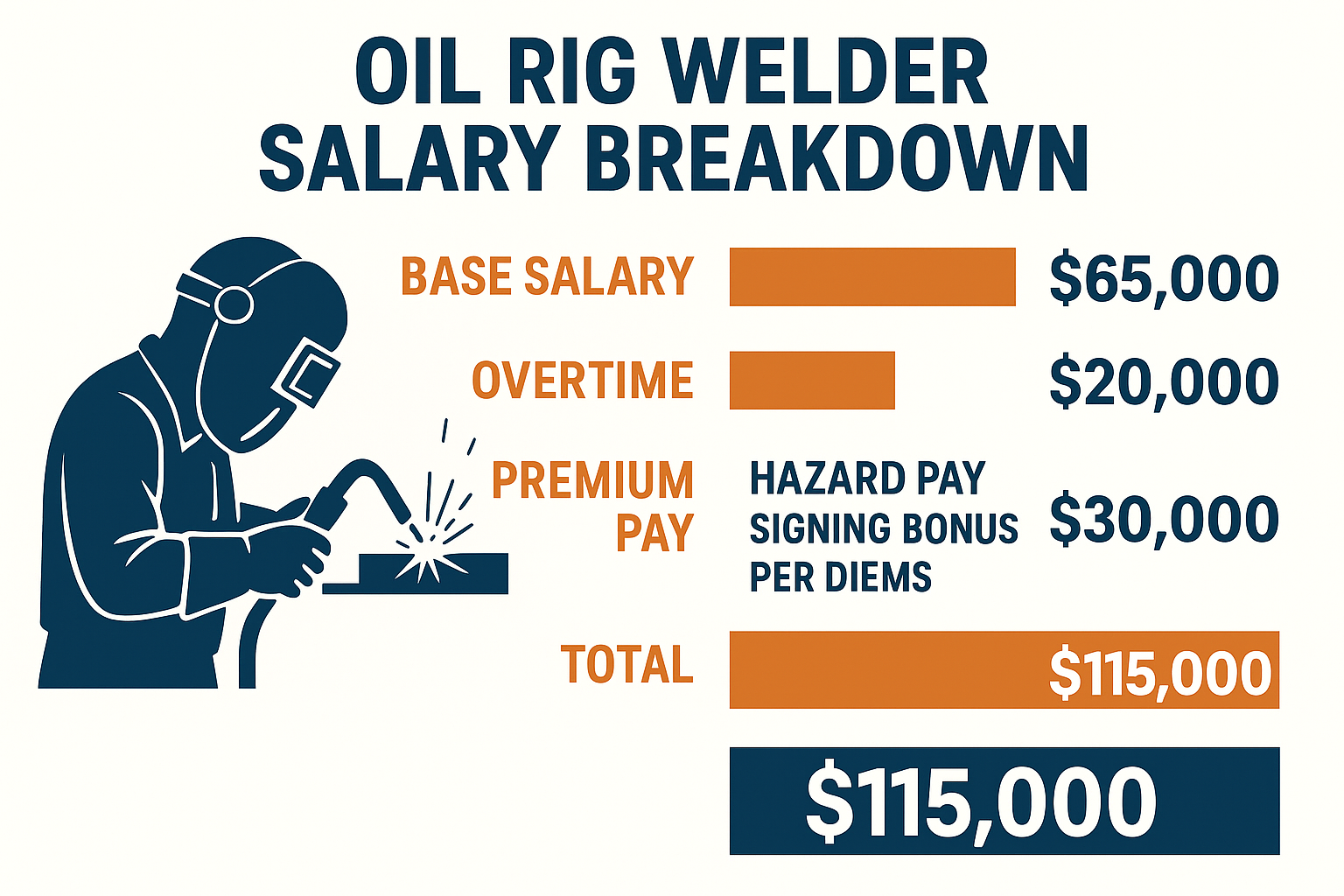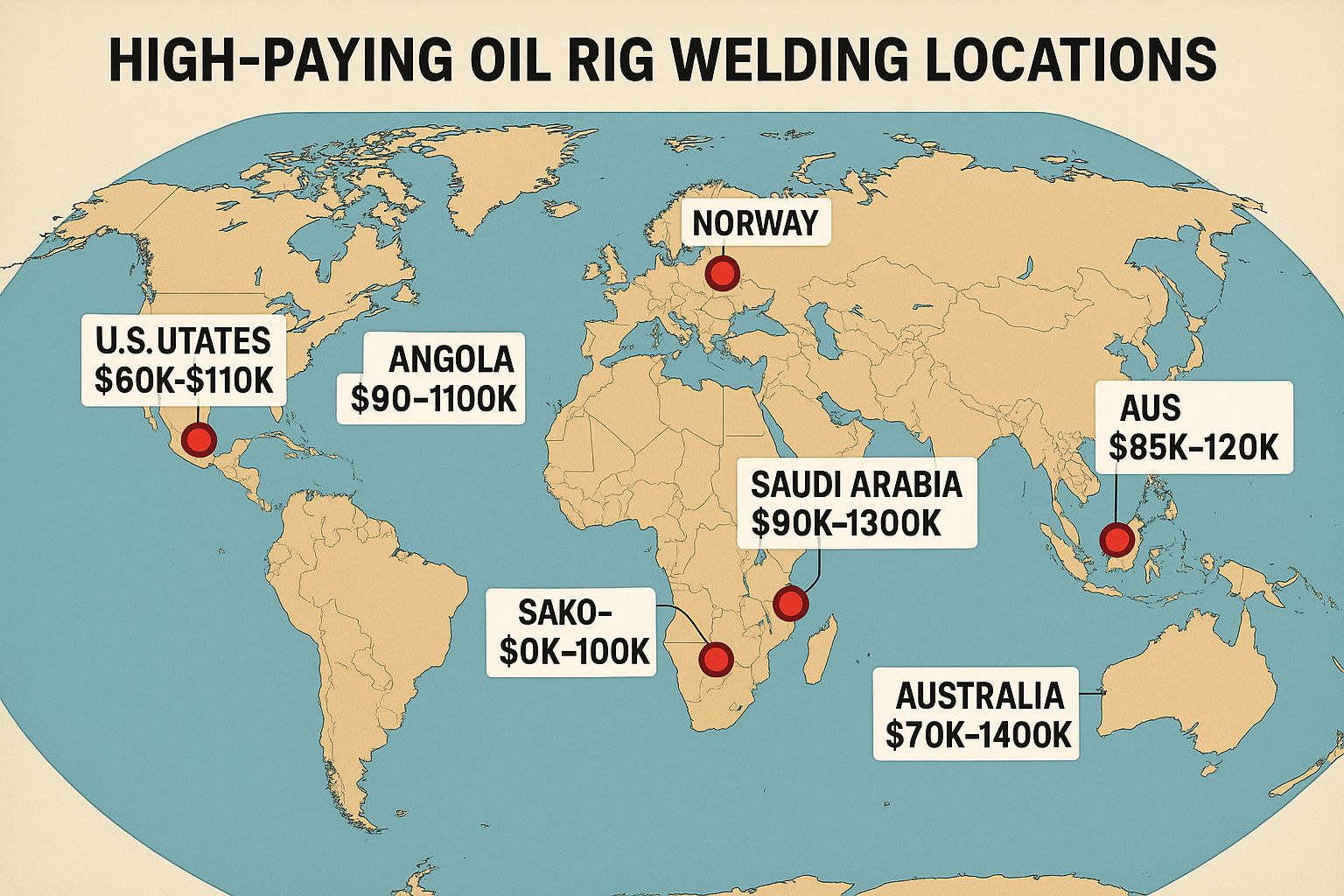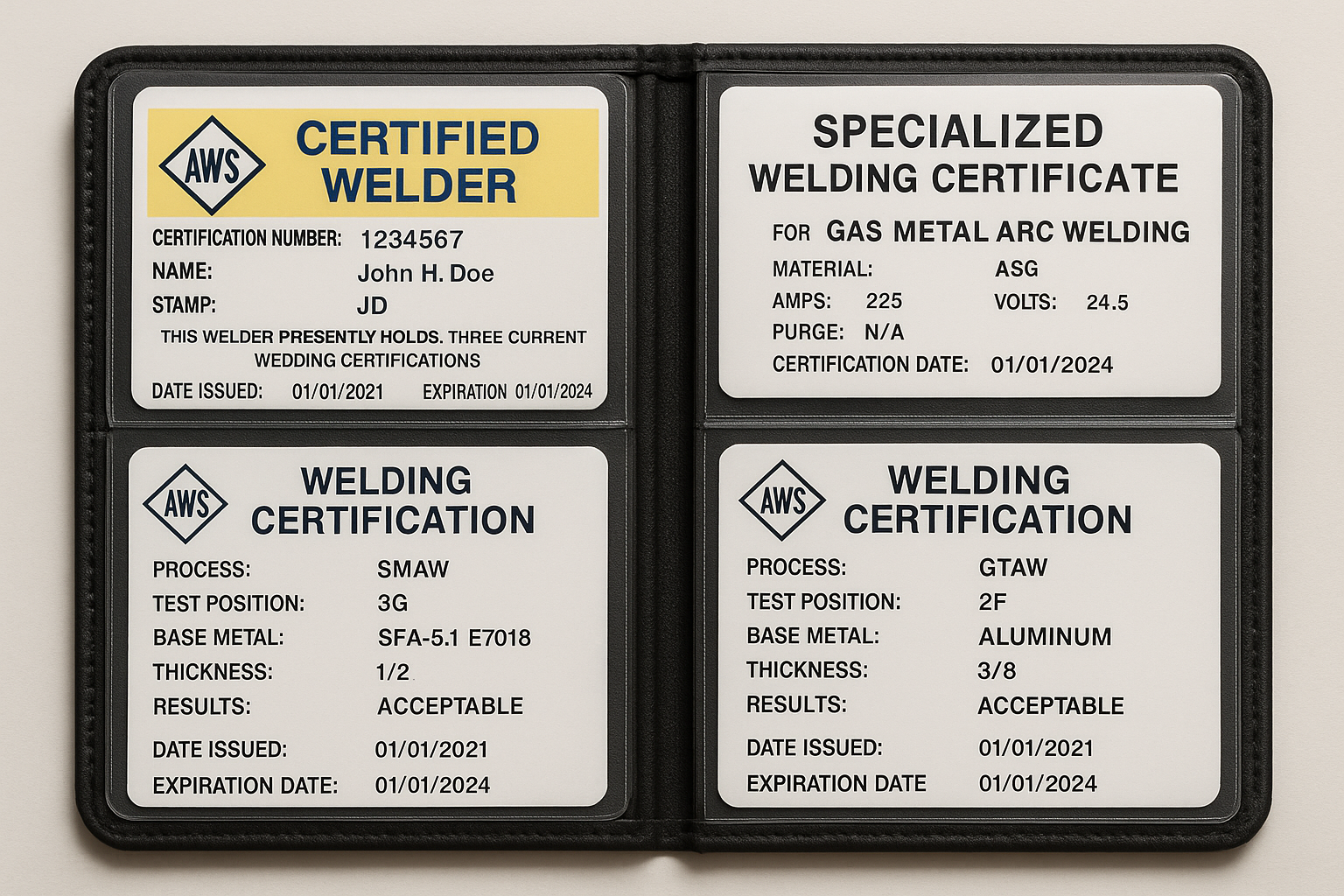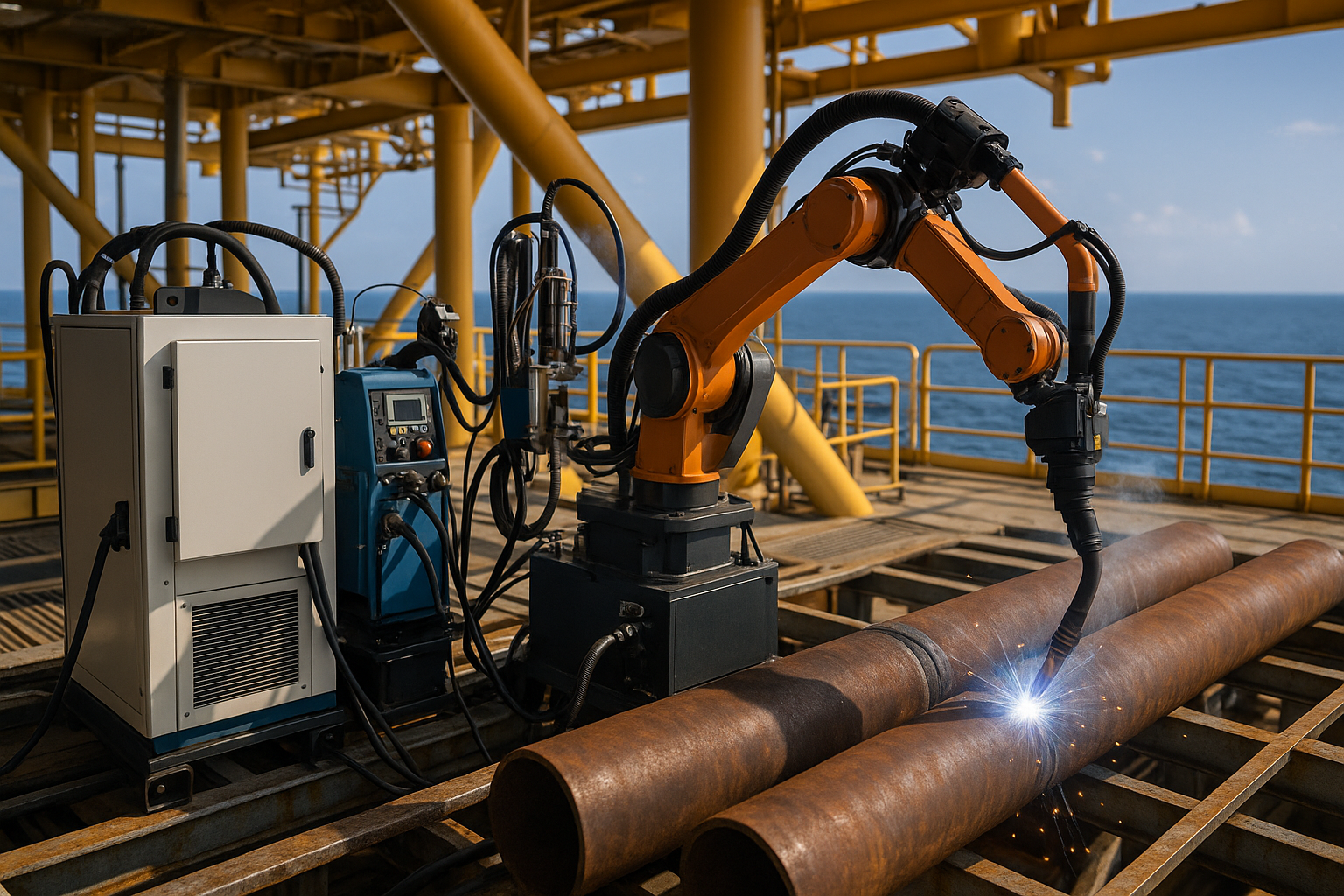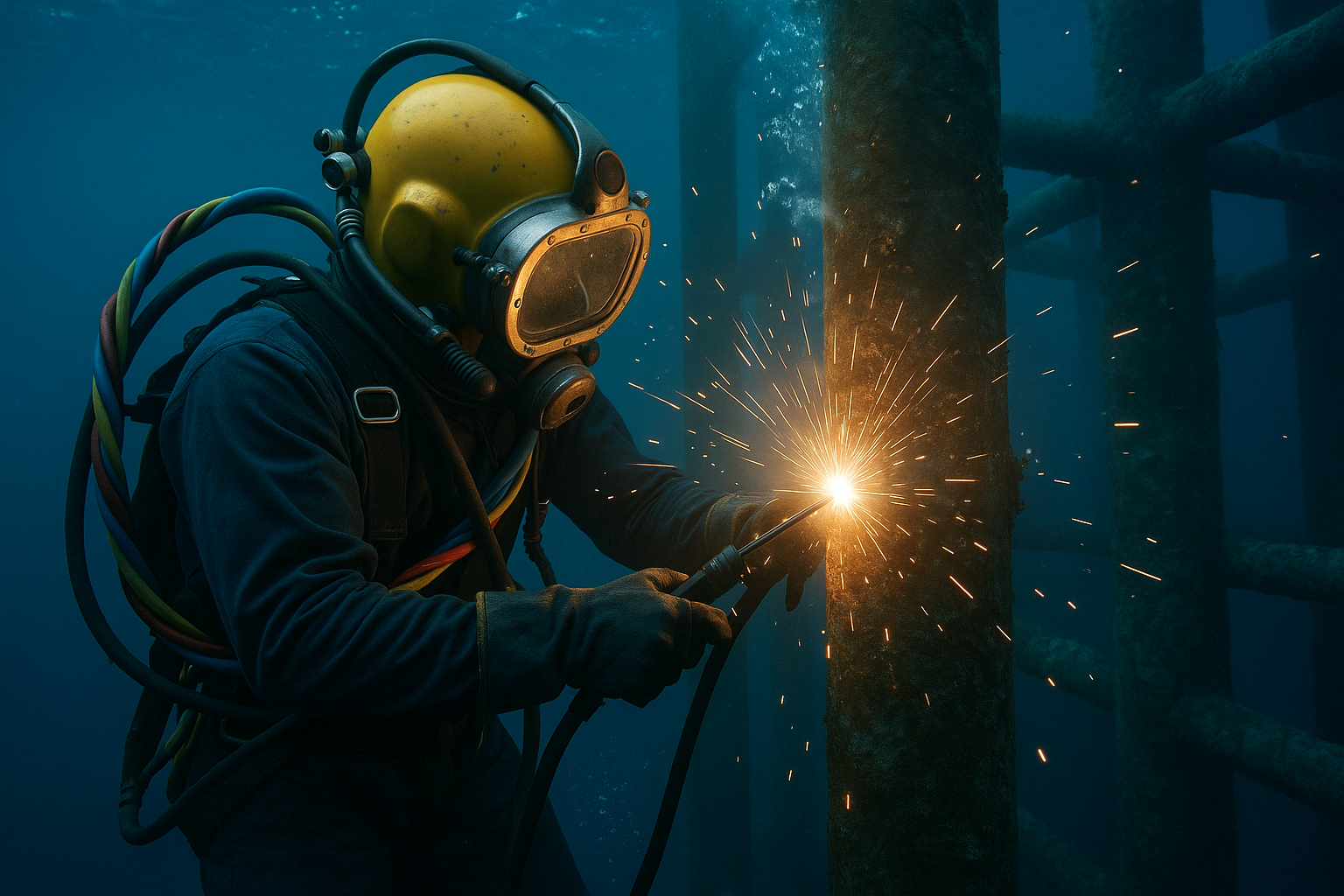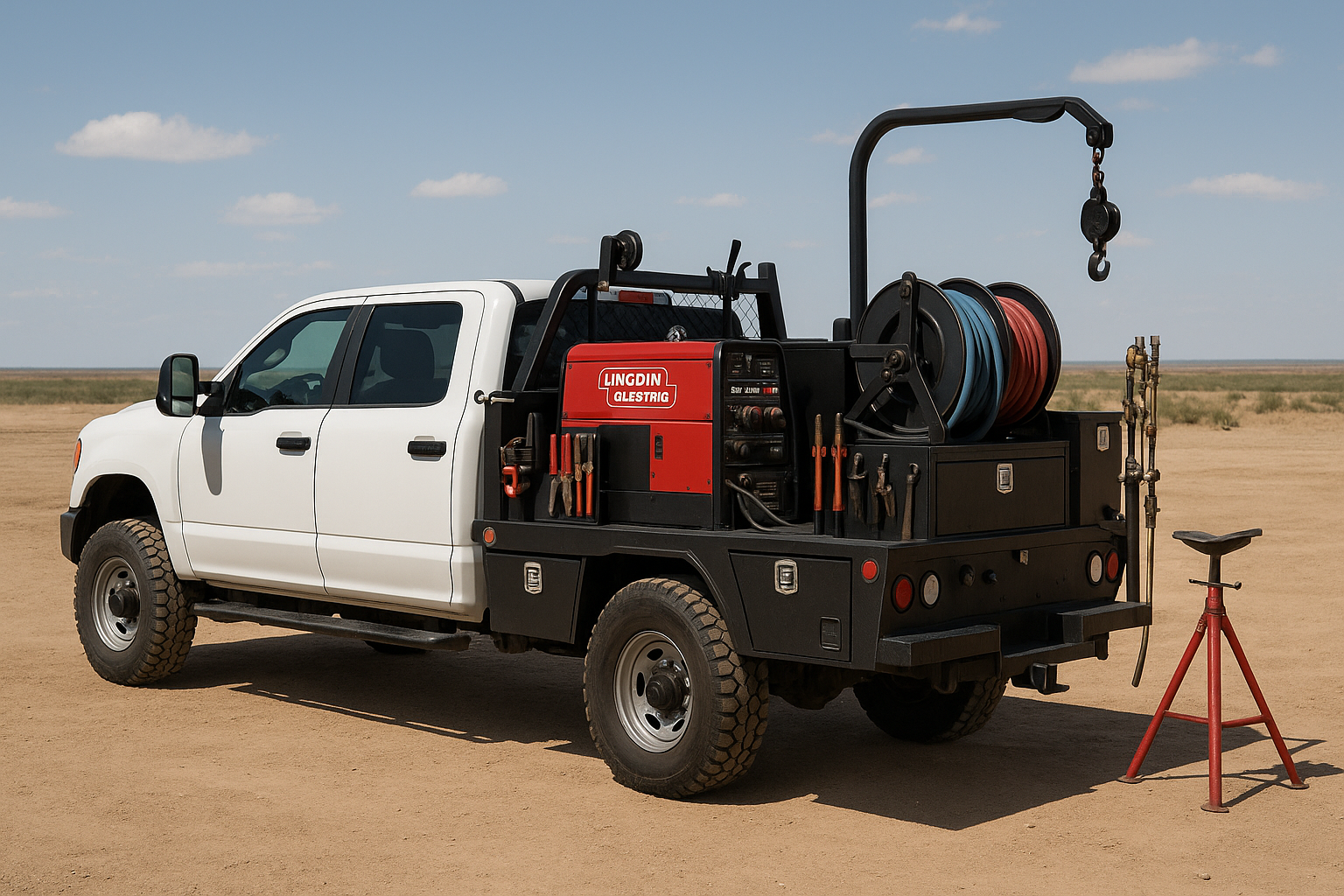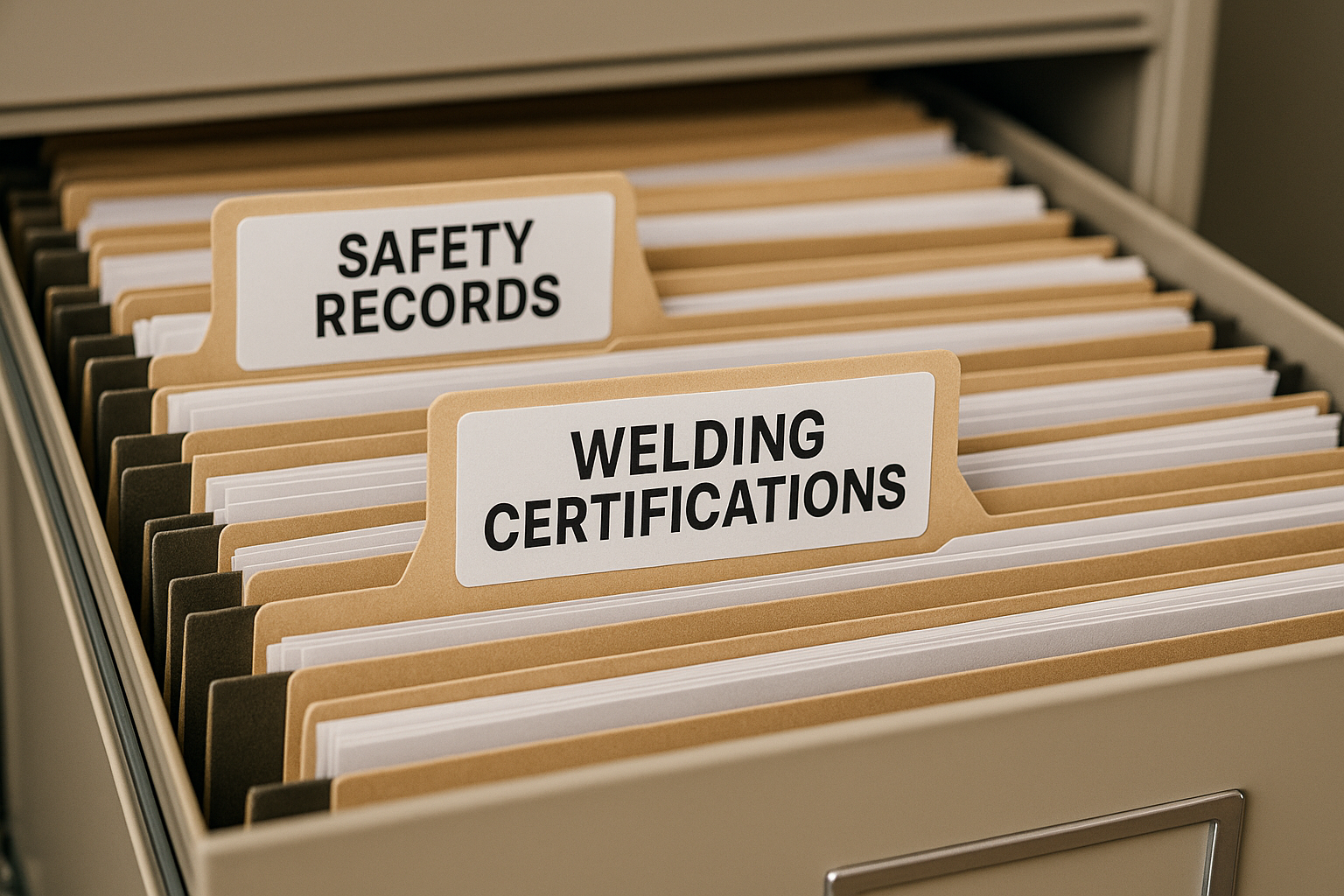While the U.S. Bureau of Labor Statistics reports that average welders earn between $13.20 and $19.61 per hour, oil rig welders operate in a completely different financial universe. Offshore welders may start at $60,000 annually and can earn $100,000 or more after gaining experience, with the most skilled underwater welders commanding salaries of $100,000 to $200,000 per year according to the American Welding Society.
Table of Contents
- The Real Money Behind Oil Rig Welding (It’s Not What You Think)
- Why Location Makes or Breaks Your Paycheck
- The Certification Game That Multiplies Your Worth
- Hidden Benefits That Add Thousands to Your Take-Home
- Career Moves That Separate the $50K from $150K+ Welders
- Underwater Welding: The Ultimate Pay Grade
- Negotiation Tactics That Actually Work
- Documentation Strategies for Maximum Opportunities
TL;DR
- Oil rig welder salaries range from $55K onshore to $300K+ for specialized underwater work
- Geographic location can increase your pay by 40-60%, with international assignments paying 2-3x domestic rates
- Multiple certifications create stacking premiums of 25-40% above base salary
- Hidden benefits like free housing and meals add $20K-$40K in annual value
- Emergency response welders earn $100-$200/hour during crisis situations
- Independent contracting can boost effective rates by 25-50%
- Proper documentation and certification management opens doors to premium opportunities
The Real Money Behind Oil Rig Welding (It’s Not What You Think)
I’ve spent years watching welders get blindsided by the complexity of oil rig compensation. Most people think oil rig welder salary discussions revolve around hourly wages, but that’s missing the bigger picture entirely. The real money lives in a sophisticated ecosystem where your base pay is just the foundation.
According to OilJobFinder, welders who work offshore on an oil rig may start out as high as $60,000 annually, earning $100,000 or more after a few years, while the American Welding Society reports that experienced underwater welders may earn $100,000 to $200,000 per year. But here’s what they don’t tell you – hazard premiums, location differentials, and performance bonuses can easily double or triple what you’re actually taking home.
Understanding how much does an oil rig worker make requires looking beyond the advertised rates. I’ve seen welders miss out on thousands simply because they didn’t know these premium categories existed.
Breaking Down the Premium Pay Structure
The compensation structure operates on layers that create exponential earning opportunities. Each layer represents a chance to increase your income, from basic hazard pay to specialized skill premiums. Too many rig welders miss out on thousands simply because they don’t understand these premium categories exist.
Understanding the complete compensation package is essential for career planning, and having proper documentation of your qualifications through services like welder qualification verification ensures you can access these premium opportunities when they arise.
| Pay Component | Base Rate | Premium Multiplier | Annual Value |
|---|---|---|---|
| Base Hourly Rate | $35-45/hour | 1.0x | $70,000-$90,000 |
| Hazard Pay | +$5-15/hour | 1.2-1.5x | $10,000-$30,000 |
| Location Premium | +$8-20/hour | 1.3-1.8x | $15,000-$40,000 |
| Certification Bonus | +$3-10/hour | 1.1-1.4x | $6,000-$20,000 |
| Performance Bonus | Varies | 1.1-1.6x | $7,000-$45,000 |
Hazard Pay Classifications That Boost Your Rate
Different hazardous conditions carry specific premium rates that significantly impact your daily earnings. H2S exposure, confined space work, and high-altitude welding each have distinct pay multipliers. Smart rig welders learn to identify and strategically accept these higher-risk assignments to maximize their hazard pay opportunities.
A rig welder working on a Gulf of Mexico platform with H2S exposure might earn a base rate of $40/hour, but with hazard pay premiums, their effective rate jumps to $55-60/hour. Over a 12-hour shift, that’s an additional $180-240 per day just from hazard classifications.
Performance Bonuses Most Welders Never See
Elite performers access bonus structures that aren’t advertised in job postings. These performance-based accelerators reward rig welders who consistently deliver quality work on time and maintain excellent safety records. The top 10% of welders often earn these bonuses that can add $10K-$30K annually to their base compensation.
The Geographic Money Map
Where you work determines your earning potential more than almost any other factor. Geographic location creates dramatic variations in compensation that most people underestimate. Understanding these regional multipliers helps you make strategic decisions about where to focus your job search.
Offshore vs Onshore: The $30K+ Difference
Offshore rig welders consistently out-earn their onshore counterparts by $25K-$45K annually. This premium exists because of isolation, weather exposure, and emergency response requirements. The gap widens even more when you factor in the elimination of living expenses during rotation periods.
Data from Capitol Iron Works shows that the highest paying underwater welding jobs are offshore oil rig positions in locations like the Gulf of Mexico, where salaries range from $40,000 to over $200,000 per year, while North Sea region underwater welders earn $60,000-$100,000.
International Assignments: Your Ticket to Premium Rates
International rig welding positions offer the highest compensation multipliers in the industry. Assignments in politically unstable regions or harsh environments command premium rates plus hardship allowances. I’ve seen rig welders earn their entire annual domestic salary in just 3-4 months on these assignments.
Why Location Makes or Breaks Your Paycheck
Geographic location creates dramatic variations in rig welder salary that most people underestimate. The difference between working in Texas versus the Gulf of Mexico versus international waters can mean the difference between a decent living and serious wealth building.
The manufacturing industry’s need for “3.8 million new workers by 2033” according to the Manufacturing Institute and Deloitte is driving increased demand for skilled welders, particularly those willing to work in challenging offshore environments where premium rates are standard.
Understanding these regional dynamics helps you position yourself in the highest-paying markets. I’ve mapped out how location premiums work across different regions, and the differences are staggering.
Regional Premium Hotspots
Certain geographic regions consistently offer premium compensation due to environmental challenges, regulatory requirements, or political risk factors. These hotspots change based on industry activity, but knowing how to identify and access them gives rig welders a significant advantage in maximizing earning potential.
Gulf of Mexico: The Domestic Premium Standard
Gulf of Mexico operations set the benchmark for domestic premium rates, typically paying 40-60% more than onshore positions. The combination of offshore challenges, hurricane season risks, and deep-water technical requirements creates consistent demand for premium-rate rig welders in this region.
International Waters: Where the Real Money Lives
International assignments represent the highest earning potential for oil rig welders. West Africa, North Sea, and Middle Eastern operations offer base rates that are 2-3 times domestic levels, plus additional allowances for political risk, harsh conditions, and extended rotations away from home.
Market Timing Strategies
Understanding industry cycles and regional activity patterns allows strategic welders to position themselves for maximum earnings. Knowing when and where demand peaks helps you negotiate better rates and secure the most lucrative assignments before competition increases.
For welders looking to transition into higher-paying specialized roles, understanding the complete career progression is crucial, which is why resources like become underwater welder guide can provide valuable insights into maximizing earning potential through strategic career moves.
The Certification Game That Multiplies Your Worth
Certifications in oil rig welding aren’t just requirements – they’re income multipliers that can add $5K-$15K per specialty to your annual earnings. The key is understanding which certifications stack for maximum premium and how to strategically build a portfolio that opens doors to exclusive high-paying opportunities for any rig welder.
I’ve watched welders invest their training time and money without understanding which combinations create exponential rather than additive value increases. This strategic approach separates the welders earning $60K from those pulling in $120K+ annually.
High-Value Certification Combinations
Certain certification combinations create exponential rather than additive value increases. Understanding which certifications complement each other and which ones open doors to specialized markets helps rig welders invest their training time and money for maximum return on investment.
Research from Capitol Iron Works indicates that having a saturation diving certification can add $10,000-$20,000 to an underwater welder’s yearly pay, while expertise in hyperbaric welding often results in around 25% higher base pay.
The 6G Pipe Certification Premium
6G pipe certification remains one of the most valuable credentials for oil rig welders, commanding consistent premiums across all market segments. This certification demonstrates your ability to weld in all positions and opens access to critical pipeline and structural work that pays premium rates.
Maintaining proper documentation of your certifications is crucial for accessing premium opportunities, and services like replacement certifications ensure you never miss out on high-paying assignments due to lost or damaged credentials.
Exotic Materials: Your Gateway to Elite Assignments
Certifications in titanium, Inconel, and other exotic alloys used in deep-water applications create an exclusive talent pool. These specialized materials require precise techniques and extensive training, which translates to 30-50% salary premiums for qualified welders.
Certification Timing and Renewal Strategy
Strategic timing of certification renewals and new certifications can maximize your return on investment. Aligning your certification schedule with peak hiring seasons and project cycles ensures you’re qualified for the highest-paying opportunities when they become available.
Certification Planning Checklist:
- Research peak hiring seasons for your target markets
- Plan certification renewals 6 months before expiration
- Stack complementary certifications for maximum premium
- Budget for continuing education and recertification costs
- Document all training hours and maintain detailed records
- Network with certification instructors for job leads
Hidden Benefits That Add Thousands to Your Take-Home
The true value of oil rig welding positions extends far beyond your hourly rate. Hidden compensation components can add $20K-$40K in annual value to your package. Understanding and maximizing these benefits is crucial for accurate compensation comparison and financial planning.
Most welders focus solely on their base pay rate and miss the bigger financial picture. I’ve seen welders turn down positions that would have increased their real purchasing power by 30% because they only looked at the hourly wage.
Living Expense Elimination Benefits
Offshore workers receive comprehensive living support that eliminates major expenses during rotation periods. Free room and board, meals, and transportation can be worth $15K-$25K annually, effectively increasing your take-home pay by reducing your cost of living.
Housing and Meal Value Calculations
The value of provided housing and meals varies by location and quality, but typically ranges from $40-$80 per day. Over a full rotation schedule, this benefit alone can be worth $15K-$30K annually, money that stays in your pocket instead of going to rent and groceries.
A welder on a 14-day rotation schedule receiving $60/day in housing and meal benefits accumulates $15,600 in annual value (26 rotations × 14 days × $60). This effectively increases a $80,000 salary to $95,600 in real purchasing power.
Transportation and Travel Allowances
Many positions include transportation to and from the rig, plus travel allowances for international assignments. These benefits can add $3K-$10K annually to your compensation package, depending on your home location and assignment distance.
Insurance and Retirement Benefits
Comprehensive insurance packages and retirement contributions often exceed what’s available in other industries. Understanding the full value of these benefits helps you make accurate compensation comparisons and long-term financial planning decisions.
| Benefit Category | Annual Value Range | Tax Advantage | Effective Increase |
|---|---|---|---|
| Housing & Meals | $15,000-$30,000 | Tax-free | 20-35% |
| Transportation | $3,000-$10,000 | Reimbursed | 5-12% |
| Health Insurance | $8,000-$15,000 | Pre-tax | 10-18% |
| Retirement Match | $4,000-$12,000 | Tax-deferred | 5-15% |
| Life Insurance | $1,000-$3,000 | Company-paid | 1-4% |
Career Moves That Separate the $50K from $150K+ Welders
The difference between average-earning and high-earning oil rig welders isn’t just skill – it’s strategic career positioning. Understanding industry cycles, building specialized expertise, and developing the right professional relationships creates access to exclusive opportunities that command premium compensation.
With “welders always in high demand” according to Thomas Insights, and the rise of advanced technologies requiring specialized skills, welders who position themselves in emerging technologies and automation-integrated roles are commanding premium rates in the evolving industrial landscape.
I’ve watched welders with similar technical abilities earn vastly different salaries based purely on their strategic career decisions. The highest earners understand that success requires more than welding expertise.
Skill Specialization Pathways
Developing expertise in emerging technologies and specialized applications creates exclusive opportunities unavailable to general practitioners. The key is identifying which specializations will be in highest demand and positioning yourself ahead of the curve.
Automated Welding Systems Expertise
As the industry adopts more automated welding systems, welders who understand both traditional techniques and automated processes become invaluable. This dual expertise commands premium rates and provides job security as technology evolves.
Emergency Response Specialization
Welders certified for emergency repairs and blowout response earn premium rates during crisis situations. Some specialists earn $50K+ in a single emergency deployment, making this one of the highest-paying specializations in the industry.
Network Development and Reputation Building
Building relationships with key contractors, supervisors, and safety managers creates access to exclusive opportunities that bypass competitive bidding processes. Your professional network often determines which opportunities you even hear about, let alone have access to.
According to “The Fabricator”, experienced pipeline welders can earn as much as $5,000 for a single 60-hour workweek, with payment structures including arm pay ($36-52/hour), truck pay ($15-25/hour), and per diem ($100-150 per seven days), demonstrating how strategic career positioning in pipeline work creates exceptional earning opportunities.
Contractor Relationship Management
Maintaining strong relationships with 3-5 key contractors provides consistent work at preferred rates. These relationships often result in 15-25% higher earnings compared to welders who compete for open positions without established connections.
Keith Armentrout, a 30-year pipeline welding veteran, emphasized the importance of reputation and relationships: “What I would make in one week is what an average American would make in a month.” His success came from building trust with contractors who knew they could rely on his quality work under pressure.
Pipeline welder Keith Armentrout’s career illustrates the earning potential: working 60 hours per week, he could earn $36-52/hour for welding, $15-25/hour for truck usage, plus $100-150 per diem, totaling up to $5,000 weekly. However, he emphasizes hidden costs like RV park fees of $700-1,000 monthly in oil-rich areas, showing the importance of calculating net earnings rather than just gross pay.
Underwater Welding: The Ultimate Pay Grade
Underwater welding represents the pinnacle of oil rig welding compensation, with unique pay structures that reflect extreme technical demands and safety risks. Understanding hyperbaric welding rate structures and depth-based multipliers is crucial for welders considering this specialized career path.
The underwater welding pay scale operates on completely different principles than surface welding. I’ve seen underwater welders earn more in a single month than many surface welders make in six months, but the path to get there requires serious commitment and risk tolerance.
Hyperbaric Welding Rate Structures
Underwater welding pay scales operate on depth-based multipliers that increase exponentially with working depth. Rates start at $300-500 per day for shallow work and can exceed $1,000+ per day for deep-water structural repairs requiring extensive decompression protocols.
For those considering this specialized career path, understanding the complete journey is essential, which is why comprehensive resources like underwater welding salary secrets provide crucial insights into maximizing earning potential in this high-risk, high-reward field.
Depth-Based Pay Multipliers
Pay rates double at 60+ feet and triple beyond 100 feet due to increased decompression requirements and risk factors. Understanding these multipliers helps underwater welders target the most lucrative depth ranges for maximum earning potential.
Emergency Underwater Repair Premiums
Emergency underwater welding on critical oil rig infrastructure commands rates of $150-300 per hour. Some specialists earn $10K+ for single emergency repairs during weather windows, making emergency response one of the highest-paying aspects of underwater welding.
Commercial Diving Integration Benefits
Combining commercial diving certifications with welding expertise opens access to exclusive opportunities in offshore inspection, maintenance, and emergency response roles. This combination creates a rare skill set that commands premium compensation packages.
Underwater Welding Career Progression Checklist:
- Complete commercial diving certification (ACDE approved)
- Obtain AWS underwater welding certifications
- Build experience in shallow water applications first
- Develop expertise in hyperbaric welding techniques
- Pursue saturation diving credentials for deep-water work
- Maintain excellent safety record and medical certifications
- Network with offshore diving contractors and supervisors
Negotiation Tactics That Actually Work
Effective salary negotiation in oil rig welding requires understanding industry benchmarks, contractor profit margins, and project economics. Armed with this knowledge, you can position your requests within profitable ranges for employers while maximizing your earning potential.
Most welders approach salary negotiations from a position of weakness because they don’t understand the economics driving their employer’s decisions. I’ve seen welders leave $10K-$20K on the table annually because they didn’t know how to frame their value proposition effectively.
Understanding Contractor Economics
Contractors typically mark up labor costs by 40-60%, which means there’s room for negotiation within their profit margins. Understanding these economics helps you position salary requests that benefit both you and your employer.
Project Complexity Premium Identification
High-pressure, high-temperature, and deep-water projects command 20-40% salary premiums. Learning to identify and target these complex projects helps you maximize your earning potential by focusing on the highest-paying opportunities.
Market Rate Research Strategies
Effective negotiation requires current market intelligence about regional rates, project complexity factors, and competitor pricing. This research provides the foundation for confident, data-driven salary discussions.
Alternative Employment Models
Independent contracting, specialized consulting, and equipment ownership models can significantly increase earning potential for experienced welders willing to take on additional business responsibilities and manage irregular income streams.
For welders considering specialized career paths that command premium rates, understanding the complete educational and certification requirements is crucial, which is why resources like become certified welder secrets provide valuable insights into maximizing career advancement opportunities.
Documentation Strategies for Maximum Opportunities
Proper documentation, certification maintenance, and credential presentation are critical for accessing high-paying opportunities in oil rig welding. The industry’s emphasis on safety and compliance makes having complete, current documentation essential for competitive positioning.
I’ve watched qualified welders miss out on $100K+ opportunities because they couldn’t produce the right paperwork at the right time. In this industry, your documentation is your passport to premium opportunities.
Certification Portfolio Management
Building and maintaining a comprehensive certification portfolio requires strategic investment and timing. Understanding which certifications create the most value and how to present them effectively gives you a significant advantage in hiring processes and salary negotiations.
International Certification Recognition
Understanding which certifications transfer internationally and investing in globally recognized credentials opens access to higher-paying international assignments. This global perspective significantly expands your career opportunities and earning potential.
Safety Record Documentation
Maintaining comprehensive safety records and performance metrics creates competitive advantages in hiring processes. Welders with documented zero-incident safety records can command premium rates, with some contractors offering 5-10% salary bonuses for demonstrated safety performance.
Professional Presentation Standards
How you present your qualifications and work history impacts your ability to access premium opportunities. Professional documentation standards and presentation techniques help you stand out in competitive hiring processes.
For welders who’ve lost original certifications or need backup documentation for career advancement, having reliable copies of your credentials is essential. Missing or damaged documentation can cost you opportunities, especially when working internationally or transitioning between contractors.
ValidGrad offers professional document recreation services that help maintain your competitive edge without the delays of traditional replacement processes. Whether you need backup copies of trade school diplomas or welding certifications, their quick turnaround ensures administrative challenges don’t limit your access to high-paying opportunities.
Final Thoughts
The oil rig welding industry offers exceptional earning potential for those who understand how to navigate its complex compensation structures. Success isn’t just about welding skill – it’s about strategic positioning, continuous learning, and understanding the business side of the industry.
Your earning potential in this field is directly tied to your willingness to specialize, take calculated risks, and invest in your professional development. The welders earning $150K+ aren’t necessarily the most skilled with a torch – they’re the ones who’ve learned to position themselves strategically in high-value markets.
Remember that documentation and professional presentation matter as much as your technical abilities. In an industry where safety and compliance are paramount, having your credentials in order opens doors that remain closed to equally skilled welders with incomplete documentation.
